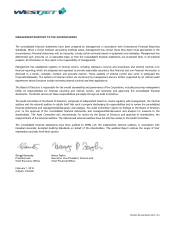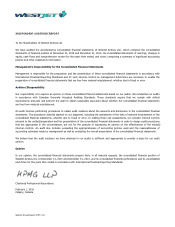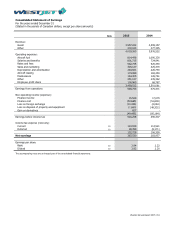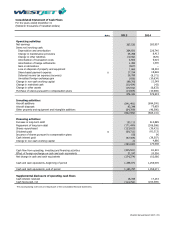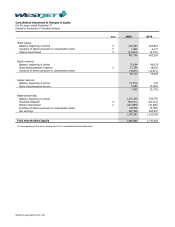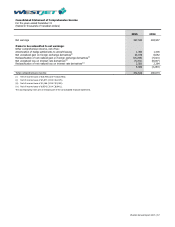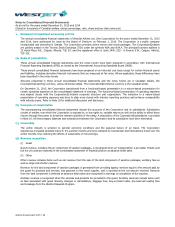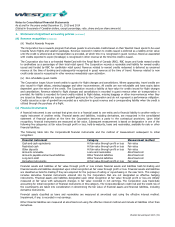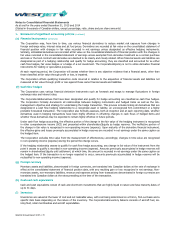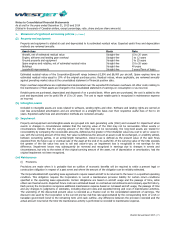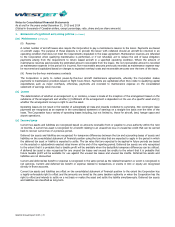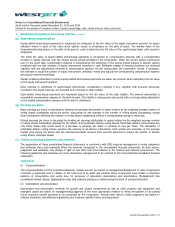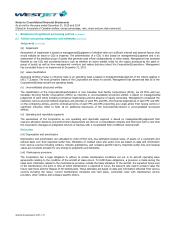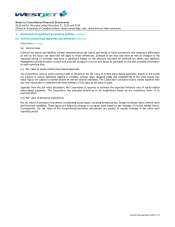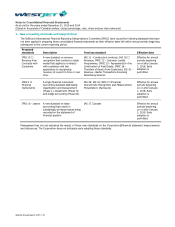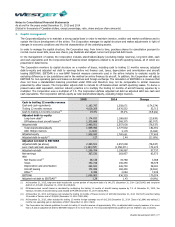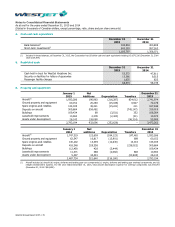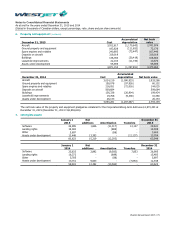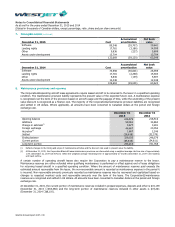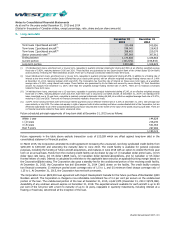Westjet 2015 Annual Report Download - page 73
Download and view the complete annual report
Please find page 73 of the 2015 Westjet annual report below. You can navigate through the pages in the report by either clicking on the pages listed below, or by using the keyword search tool below to find specific information within the annual report.
Notes to Consolidated Financial Statements
As at and for the years ended December 31, 2015 and 2014
(Stated in thousands of Canadian dollars, except percentage, ratio, share and per share amounts)
WestJet Annual Report 2015 | 71
1. Statement of significant accounting policies (continued)
(j) Property and equipment
Property and equipment is stated at cost and depreciated to its estimated residual value. Expected useful lives and depreciation
methods are reviewed annually.
Asset class
Basis
Rate
Aircraft, net of estimated residual value
Straight-line
15 to 20 years
Engine, airframe and landing gear overhaul
Straight-line
3 to 12 years
Ground property and equipment
Straight-line
3 to 25 years
Spare engines and rotables, net of estimated residual value
Straight-line
15 to 20 years
Buildings
Straight-line
40 years
Leasehold improvements
Straight-line
5 years/Term of lease
Estimated residual values of the Corporation’s aircraft range between $2,500 and $6,000 per aircraft. Spare engines have an
estimated residual value equal to 10% of the original purchase price. Residual values, where applicable, are reviewed annually
against prevailing market rates at the consolidated statement of financial position date.
Major overhaul expenditures are capitalized and depreciated over the expected life between overhauls. All other costs relating to
the maintenance of fleet assets are charged to the consolidated statement of earnings on consumption or as incurred.
Rotable parts are purchased, depreciated and disposed of on a pooled basis. When parts are purchased, the cost is added to the
pool and depreciated over its useful life of 15 to 20 years. The cost to repair rotable parts is recognized in maintenance expense
as incurred.
(k) Intangible assets
Included in intangible assets are costs related to software, landing rights and other. Software and landing rights are carried at
cost less accumulated amortization and are amortized on a straight-line basis over their respective useful lives of five to 20
years. Expected useful lives and amortization methods are reviewed annually.
(l) Impairment
Property and equipment and intangible assets are grouped into cash generating units (CGU) and reviewed for impairment when
events or changes in circumstances indicate that the carrying value of the CGU may not be recoverable. When events or
circumstances indicate that the carrying amount of the CGU may not be recoverable, the long-lived assets are tested for
recoverability by comparing the recoverable amounts, defined as the greater of the CGU’s fair value less cost to sell or value-in-
use, with the carrying amount of the CGU. Fair value is defined as the amount an asset could be exchanged, or a liability settled,
between consenting parties, in an arm’s length transaction. Value-in-use is defined as the present value of the cash flows
expected from the future use or eventual sale of the asset at the end of its useful life. If the carrying value of the CGU exceeds
the greater of the fair value less cost to sell and value-in-use, an impairment loss is recognized in net earnings for the
difference. Impairment losses may subsequently be reversed and recognized in earnings due to changes in events and
circumstances, but only to the extent of the original carrying amount of the asset, net of depreciation or amortization, had the
original impairment not been recognized.
(m) Maintenance
(i) Provisions
Provisions are made when it is probable that an outflow of economic benefits will be required to settle a present legal or
constructive obligation in respect of a past event and where the amount of the obligation can be reliably estimated.
The Corporation’s aircraft operating lease agreements require leased aircraft to be returned to the lessor in a specified operating
condition. This obligation requires the Corporation to record a maintenance provision liability for certain return conditions
specified in the operating lease agreements. Certain obligations are based on aircraft usage and the passage of time, while
others are fixed amounts. Expected future costs are estimated based on contractual commitments and company-specific history.
Each period, the Corporation recognizes additional maintenance expense based on increased aircraft usage, the passage of time
and any changes to judgments or estimates, including discount rates and expected timing and cost of maintenance activities.
The unwinding of the discounted present value is recorded as a finance cost on the consolidated statement of earnings. The
discount rate used by the Corporation is the current pre-tax risk-free rate approximated by the corresponding term of a US or
Canadian government bond to the remaining term until cash outflow. Any difference between the provision recorded and the
actual amount incurred at the time the maintenance activity is performed is recorded to maintenance expense.


